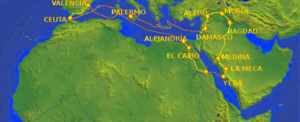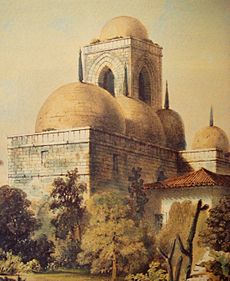Ibn Jubayr facts for kids
Quick facts for kids
Ibn Jubayr
|
|
|---|---|
| Born | 1 September 1145 |
| Died | 29 November 1217 (aged 72) |
| Occupation | Geographer, Traveler, Poet |
Ibn Jubayr (born September 1, 1145 – died November 29, 1217) was an Arab geographer, traveler, and poet from al-Andalus (which is now Spain). He is famous for his detailed travel diary. This diary describes his journey to Mecca, a holy city, between 1183 and 1185.
His writings give us a great look into the lands he visited. He wrote about the areas ruled by Saladin in Egypt and the Levant (the Middle East). On his way back, he traveled through Christian Sicily. He noted the mix of cultures there, as it had been Muslim land before. Ibn Jubayr's journey happened just before the Third Crusade, a major historical event.
Contents
Early Life and Education
Ibn Jubayr was born in 1145 in Valencia, Spain. His family belonged to the Banu Kinanah tribe. His ancestor, 'Abdal-Salam ibn Jabayr, came to Spain in 740 AD. He was part of an army from Damascus.
Ibn Jubayr studied in the town of Xàtiva. His father worked there as a government official. Later, Ibn Jubayr became a secretary. He worked for the Almohad governor of Granada.
People have wondered why Ibn Jubayr decided to travel. Some stories say he was forced to drink wine by his ruler. Feeling bad, the ruler gave him gold. To make up for this, Ibn Jubayr decided to go on the Hajj. The Hajj is a special pilgrimage to Mecca. He left Granada on February 3, 1183. A doctor from the city joined him on his journey.
Amazing Journeys of Ibn Jubayr
Ibn Jubayr's travels took him across seas and through many lands. He wrote down everything he saw and experienced.
Sea Trip to Alexandria
Ibn Jubayr started his journey from Granada. He crossed the Strait of Gibraltar to Ceuta, which was under Muslim rule. On February 24, 1183, he got on a ship from Genoa. The ship sailed towards Alexandria.
His sea journey took him past the Balearic Islands. Then they went near the west coast of Sardinia. He heard a sad story there. Eighty Muslim people had been taken from North Africa and sold as slaves. Between Sardinia and Sicily, the ship faced a terrible storm. Both Italian and Muslim sailors said it was the worst storm they had ever seen. After the storm, the ship passed Sicily and Crete. It then turned south to the North African coast. He finally arrived in Alexandria on March 26.
Exploring Egypt
Ibn Jubayr greatly admired Saladin, the new ruler of Egypt. He praised Saladin's kindness and justice. For example, he noted that Saladin's help reached everyone. This included people in mosques, hospitals, and colleges.
Saladin also helped farmers. If the Nile River did not flood enough, he would lower their taxes. Ibn Jubayr wrote that Saladin's justice made roads safe. People could travel at night without fear. Ibn Jubayr, however, did not like the previous Shi'a rulers, the Fatimids.
Wonders of Cairo
In Cairo, Ibn Jubayr saw many colleges and hostels. Saladin had built these for students and religious people. Students could find a place to stay and teachers for different subjects. They also received money for their needs. The sultan also provided baths and hospitals. Doctors would even visit students if they were sick.
Another kind act by Saladin was giving out 2,000 loaves of bread daily to the poor. Ibn Jubayr was also impressed by the huge number of mosques in Cairo. He estimated there were between 8,000 and 12,000 mosques. Sometimes, four or five mosques were on the same street!
Visiting Alexandria
When Ibn Jubayr arrived in Alexandria, he was upset. Customs officials made pilgrims pay zakat (a religious tax), even if they didn't have to. In the city, he visited the Lighthouse of Alexandria. It was still standing and he was amazed by its size and beauty.
He also liked the free colleges, hostels, baths, and hospitals. These were paid for by special funds and taxes on the city's Jews and Christians. He noted that Alexandria also had many mosques, possibly between 8,000 and 12,000. After staying for eight days, he left for Cairo.
Sights in Cairo
He reached Cairo three days later. He visited the cemetery at al-Qarafah. Many important people from Islamic history were buried there. He saw that Saladin was making the citadel walls stronger. This was to protect the whole city from future attacks by Crusaders.
Another big project he saw was a bridge over the Nile. It was being built high enough to stay above the river's yearly floods. He also saw a large, free hospital. It had separate sections for men, women, and people with mental illness. He saw the pyramids and the Sphinx. He also saw a Nilometer, a device used to measure the height of the Nile flood.
Return Through Sicily
Later in his travels, from December 1184 to January 1185, Ibn Jubayr visited Sicily. He wrote about his experiences there. He noted the interesting mix of cultures. This was because Sicily had been Muslim land before the Normans took it over.
More Journeys and Later Life
Ibn Jubayr traveled to the East two more times. These trips were from 1189–1191 and in 1217. However, he did not write about these later journeys. He passed away on November 29, 1217, in Alexandria. This happened during his second trip.
Ibn Jubayr's Important Writings
Ibn Jubayr's travel diary gives a very detailed picture of the places he visited. His book was different from other travel stories of his time. It wasn't just a list of places and buildings. It also included his thoughts on geography, culture, religion, and politics.
He wrote about the Muslims in Palermo, Sicily. He noticed their faith seemed to be weaker after the Norman conquest. He also saw how King William II of Sicily had adopted some Muslim customs. This showed the mix of cultures in the Norman-Arab-Byzantine culture.
His writing style helped create a type of travel writing called "Rihla". This is a mix of personal stories, descriptions of places, and interesting anecdotes. Ibn Jubayr's travel diary became a guide for later writers. Some even copied parts of his work without saying where they got it from. For example, Ibn Juzayy, who wrote about Ibn Battuta's travels, copied parts of Ibn Jubayr's descriptions of Damascus and Mecca.
A copy of Ibn Jubayr's original book is kept at the Leiden University Library. This copy was made in Mecca in 1470 AD. It has 210 pages. The full Arabic text was first published in 1852 by William Wright.
See also
 In Spanish: Ibn Yubair para niños
In Spanish: Ibn Yubair para niños
- Ghurabiyya Shia
- Roger I of Sicily




